Rounding out today’s tsunami of CES keynote addresses is the biggest and highest profile of them all, the CES opening keynote address. Helmed this year by NVIDIA, the opening keynote is the traditional kick-off event for the show, with the evening keynote open to all of the show’s attendees. And, if NVIDIA has their way, this will be the keynote that sets the tempo for the entire rest of the show.
NVIDIA CES 2025 Keynote Live Coverage Preview
As with most of NVIDIA’s major presentations, company CEO (and leather jacket enthusiast) Jensen Huang will be headlining NVIDIA’s CES keynote. Officially, the company is saying very little about what the keynote will cover, with the event description merely reading that NVIDIA will present “an exclusive look at groundbreaking innovations in AI, gaming, robotics, and beyond” – a very broad spectrum of categories that matches the increasingly broad NVIDIA.
Notably, this is being branded as a generalized NVIDIA presentation and not as an exclusive GeForce presentation. So while NVIDIA will likely demonstrate some consumer hardware at the show (e.g. new video cards), don’t be surprised if this keynote is less product-focused and takes on a more visionary tone, similar to other CES opening keynotes in years past. Especially as NVIDIA has their own trade show in the spring (GTC), the company has in the last few years saved their major enterprise announcements for their own event. That still leaves Huang plenty of time to talk about where he sees the all-critical field of AI going in the next few years, along with potentially introducing (or at least teasing) some hardware.
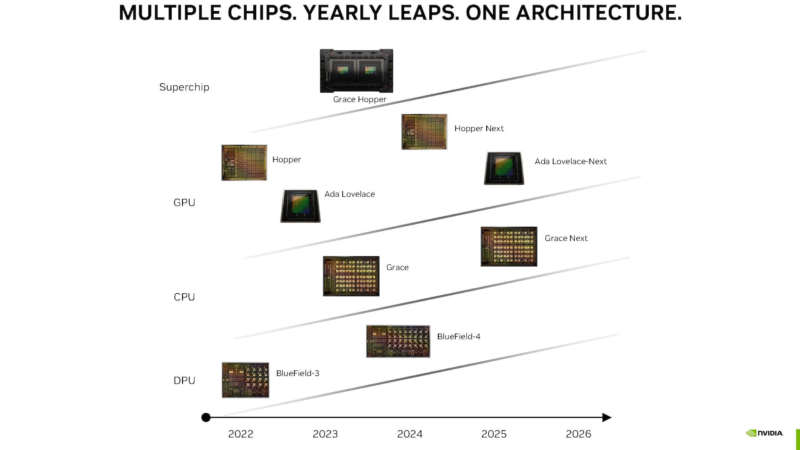
On the consumer side of matters, NVIDIA is due (if not overdue) to deliver a new generation of video cards to follow up on the GeForce RTX 4000 series and its Ada Lovelace architecture. NVIDIA already has their Blackwell architecture up and running in HPC hardware (B200 accelerators), so with any luck, we’ll see a variation of it finally trickle down to consumer hardware. Elsewhere, with the company firing on all cylinders right now, there’s always the possibility of an unexpected, dark horse consumer project.
CES is also a frequent – though not exclusive – venue for NVIDIA’s automotive announcements. DRIVE announcements have been made at both CES and GTC, so if NVIDIA is releasing a new DRIVE product – especially one making heavy use of AI functionality – it could very well surface at CES. By the same token, NVIDIA has used CES to make some robotics announcements in years past.
Otherwise, we’re expecting to see a lot of prognosticating on AI – what it can do, what industries have adopted it, and how NVIDIA wants to transform those industries.
NVIDIA’s keynote kicks off at 6:20pm PST / 9:20pm EST / 02:20 UTC, and according to NVIDIA’s calendar hold, this should be a pretty meaty keynote that runs for about 90 – and potentially a bit of overrun depending on how long CES’s own officials talk at the start of the event. So please join us in a bit for our live blog coverage of NVIDIA’s CES 2025 keynote.
NVIDIA CES 2025 Keynote Coverage Live
At this point it’s a bit past 6:20, and we’re just waiting for the NVIDIA keynote to get started. According to the CTA’s official schedule, the keynote was supposed to start at 6:20, meanwhile NVIDIA has us starting at 6:30. The livestream has already started, and while it’s in a holding pattern, you can hear the attendees in the background still getting seated.
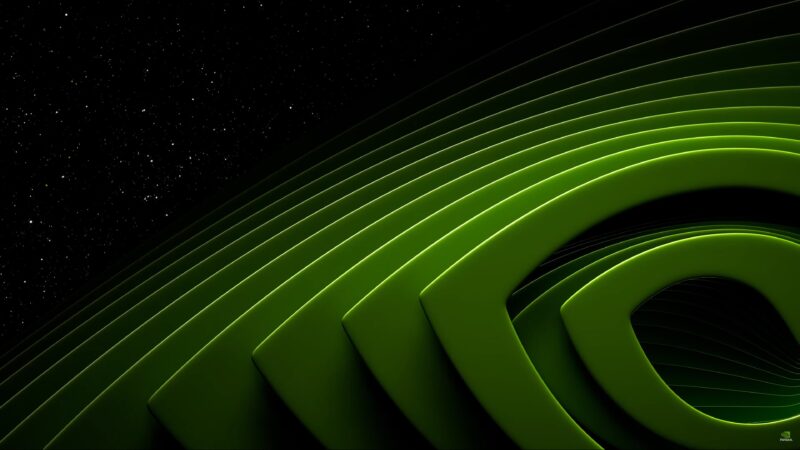
Because this is the CES opening keynote, NVIDIA has booked the largest venue available for CES: the Michelob ULTRA Arena at Mandalay Bay. So with the keynote open to all CES attendees, there’s potentially a very large crowd settling down for this one.
(Given that this is taking place in Las Vegas, who wants to take odds that NVIDIA will open up with one of their “I am AI” videos?)
We did not get a video card announcement out of AMD’s keynote today. So as a GPU enthusiast, I am going to be incredibly disappointed (and even more surprised) if we don’t get something out of NVIDIA. Especially with a 90 minute keynote.
And while I’m burning time, this week is the 10 year anniversary of the Tegra X1 SoC. NVIDIA first introduced the SoC to the press at CES 2015. The fact that NVIDIA is still selling it a decade latter in both the NVIDIA SHIELD and the Nintendo Switch is, in retrospect, kind of mind-blowing. While it was a powerful SoC for the time, I don’t think any of us were expecting it to hang around anywhere near this long. Now, where’s my next-gen SHIELD, NVIDIA?
6:35 has rolled around and here we go!

Hey, it’s not an “I am AI” video. Instead the video is all about CES, and how tech makes anything possible.
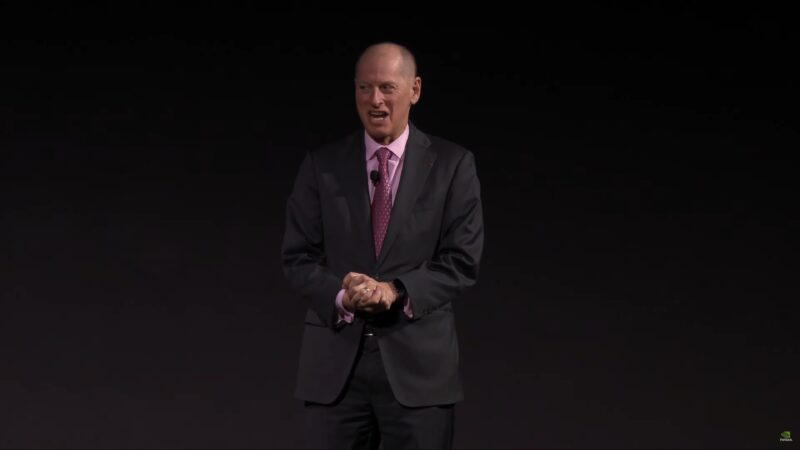
As is usually the case for an opening keynote, the CTA’s CEO, Gary Shapiro, is here to kick things off. Introducing the show itself, and NVIDIA. As well as offering plenty of platitudes for Jensen Huang himself. (Over the last year or so, Jensen’s first gig at Denny’s has been coming up a lot; it’s even in NVIDIA’s news release for this keynote)
There is a slight pause here now that Gary has left the stage.
And here we go (again).
“This is how intelligence is made”

This is a little different from the usual NVIDIA intro video fare. It’s still AI focused, but it’s all about tokens.
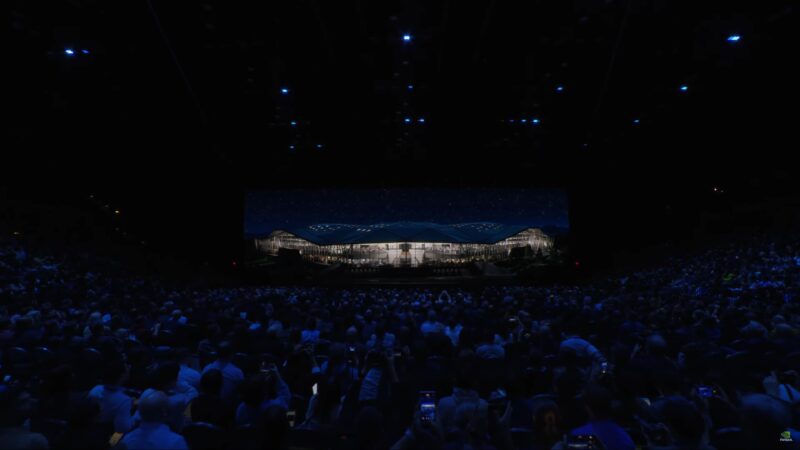
And here’s Jensen. “Welcome to CES!”
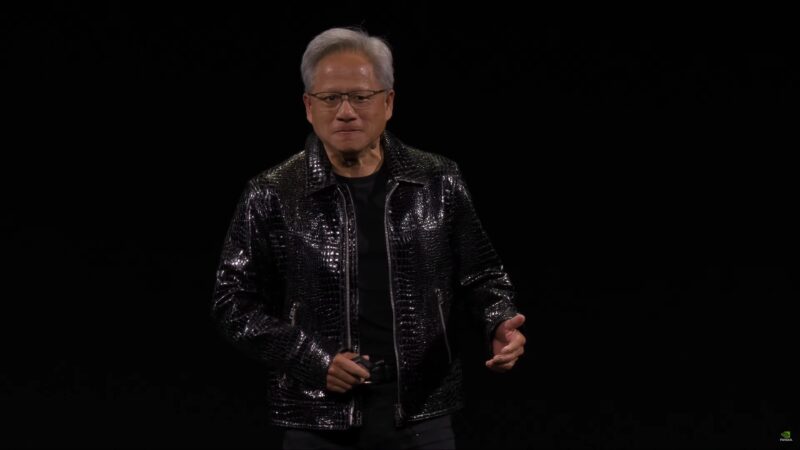
“Welcome to NVIDIA. In fact you’re inside NVIDIA’s digital twin”
“Everything here is generated by AI”
Jensen is recapping NVIDIA’s history. Starting in 1993 with NV1.
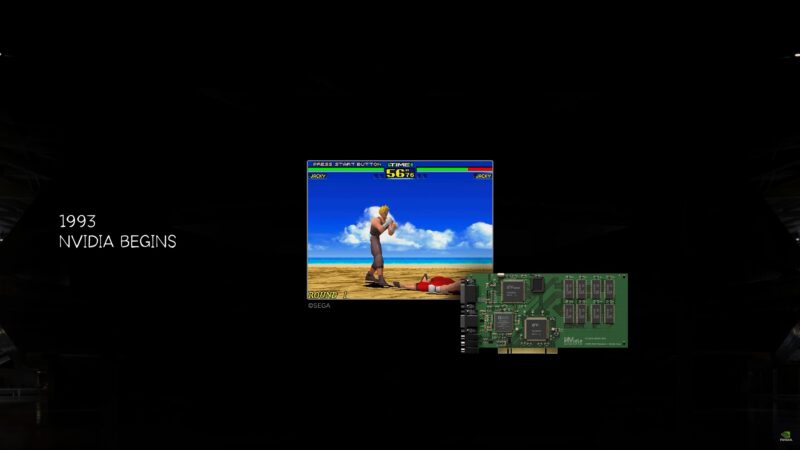
Used in Sega’s Virtua Fighter (1) arcade machine.
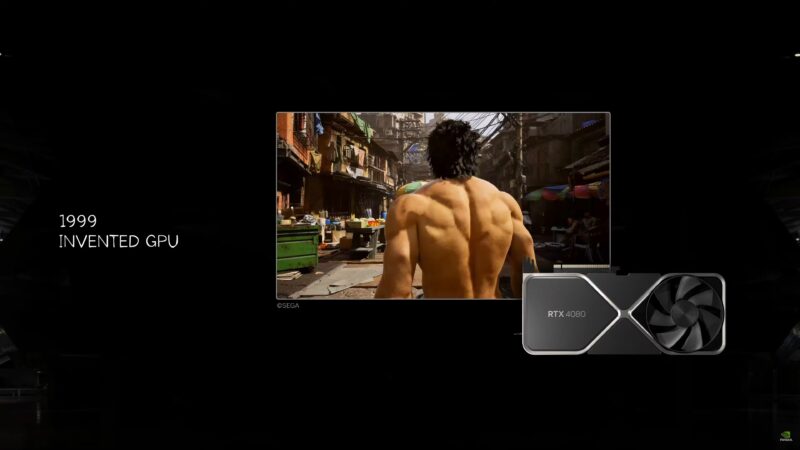
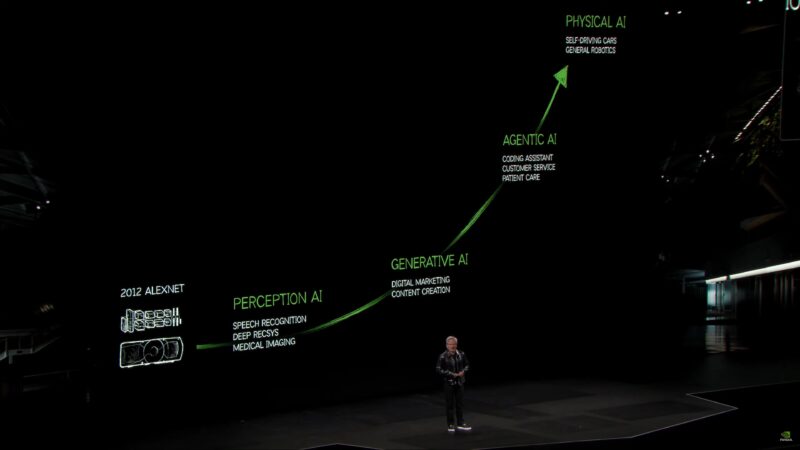
And, of course, the history of AI processing on GPUs, starting with ALEXNET in 2012.
The next phase? Physical AI. Apparently we’ll hear about this tonight.
AI took another major leap in 2018 with the creation and release of transformers by Google.
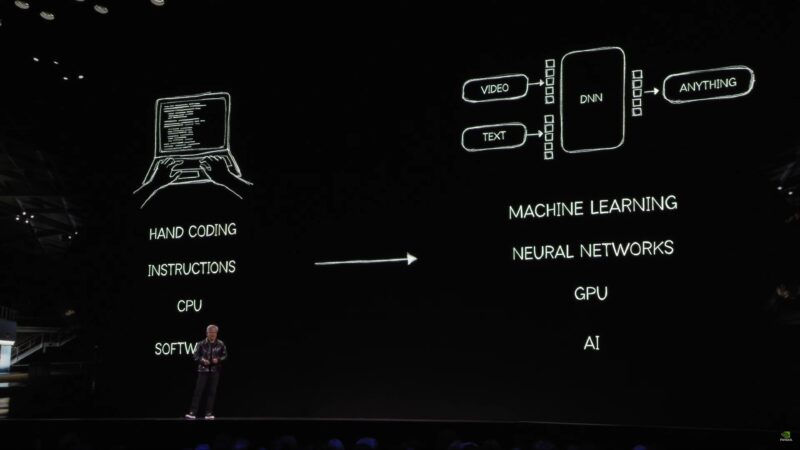
“Every single layer of the technology stack has been completely changed” in the last 12 years.
NVIDIA CES 2025 Gaming
“All of this [AI] is the house that GeForce built. Now AI is coming home to GeForce”

Now rolling a demo video, with everything captured on what NVIDIA is calling “RTX Backwell” It was recorded in real-time.
And it would have been “impossible without artificial intelligence.”
Using AI to infer the pixels that were not rendered (DLSS). Next-gen DLSS can predict up to 3 additional frames in the future beyond the current generated frame.
NVIDIA computed 2 million pixels and used AI to predict another 33 million.
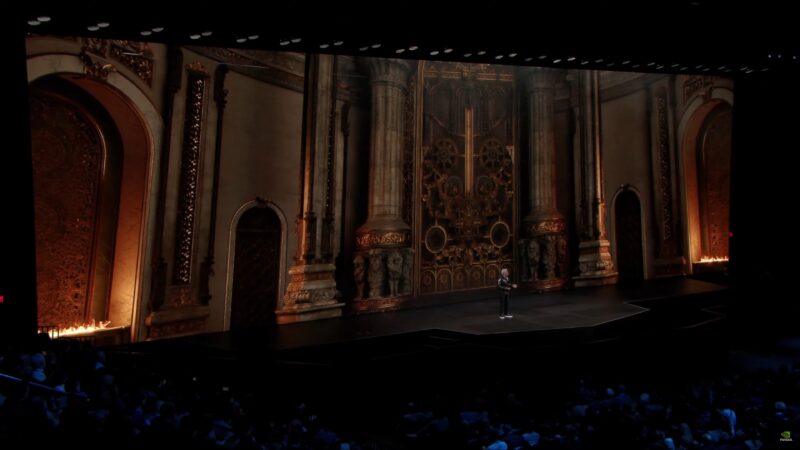
“Today we’re announcing our next generation. The RTX Blackwell Family”
92 billion transistors. 4000 TOPS.
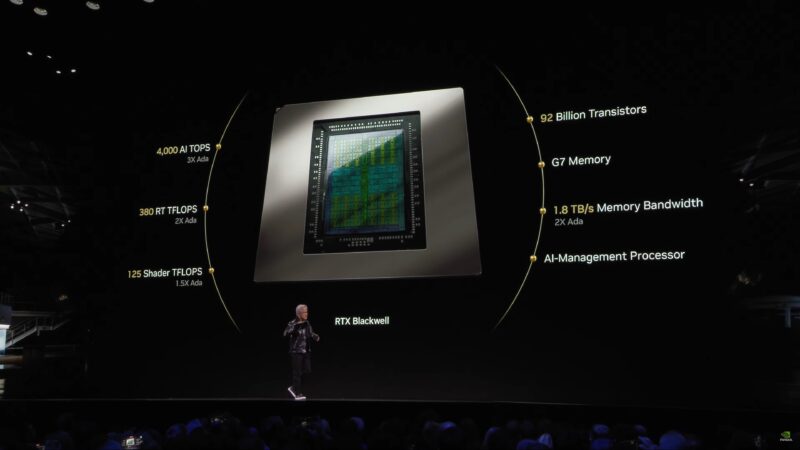
Two dual shaders. One for FP, one for Integer.
GDDR7 memory from Micron. 1.8TB/sec of memory bandwidth.
And the ability to mix AI and computer graphics workloads.
The programmable shader is now able to process neural networks.

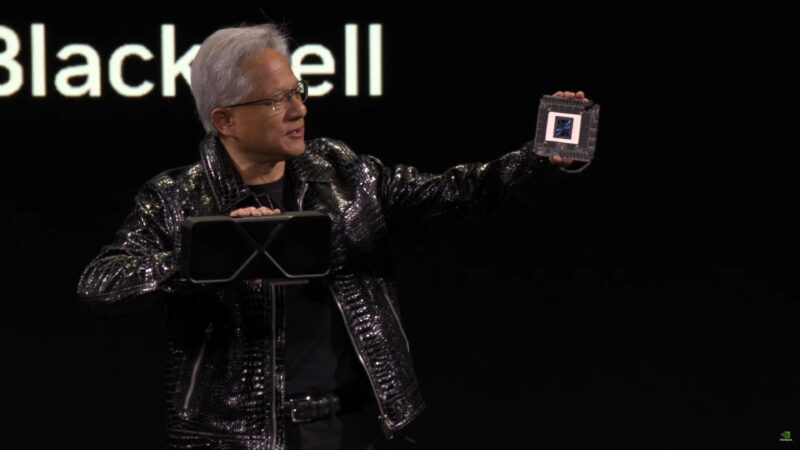
And how does it compare to the $1599 RTX 4090 series?
RTX 5070: $549 with 4090 performance.
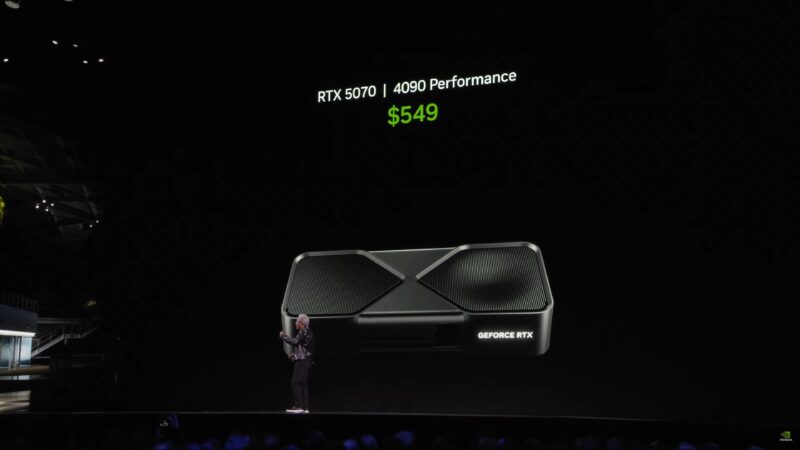
RTX 5090 for $1999.
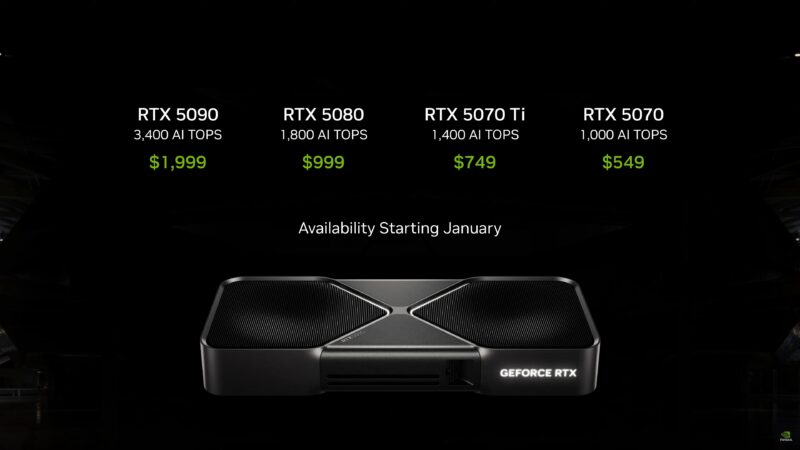
And laptop parts as well. A $1299 laptop with a laptop version of the RTX 5070.
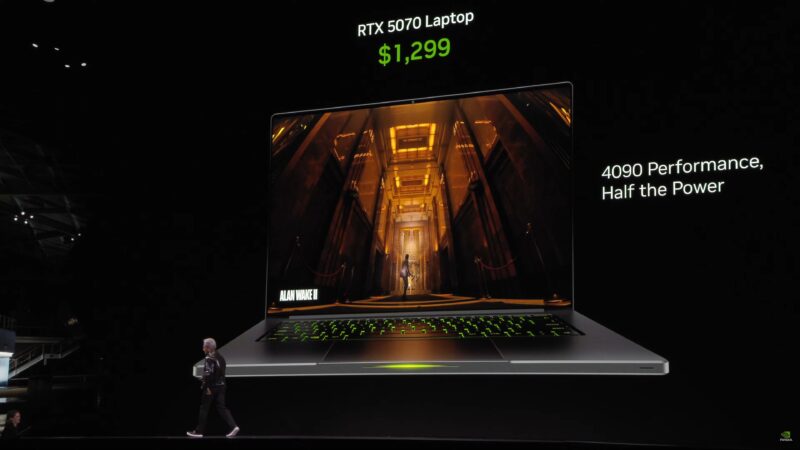
“The energy efficiency is off the charts”
“This is a surprisingly kinetic keynote”
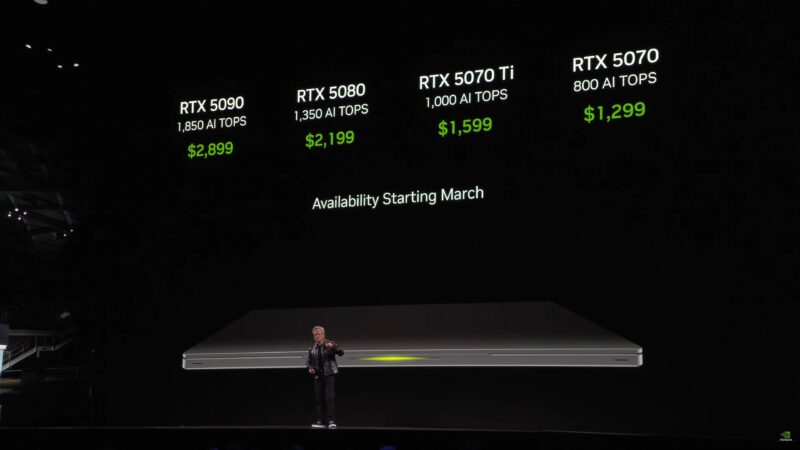
Notably, NVIDIA is using TOPS to classify/promote GPU performance. We’ll undoubtedly know more soon, since the first RTX 5000 cards are due this month.
NVIDIA CES 2025 AI Discussion
Now shifting gears to more general AI discussion.
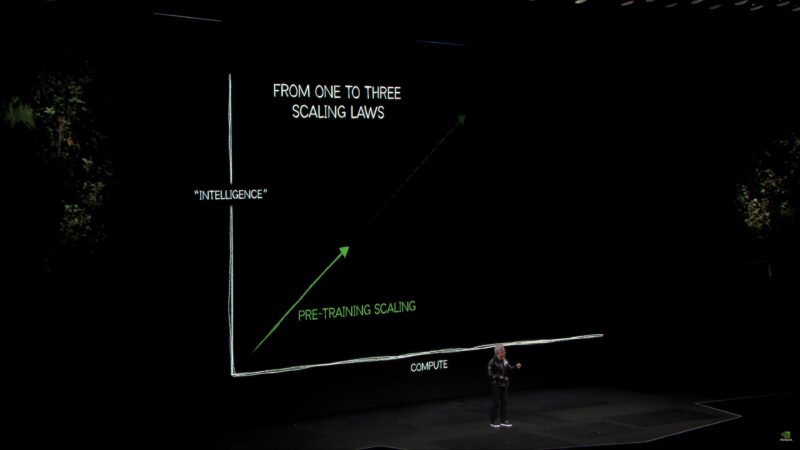
Jensen talking about scaling laws. And how there are now multiple laws: pre-training. Post-training, and “reasoning”.
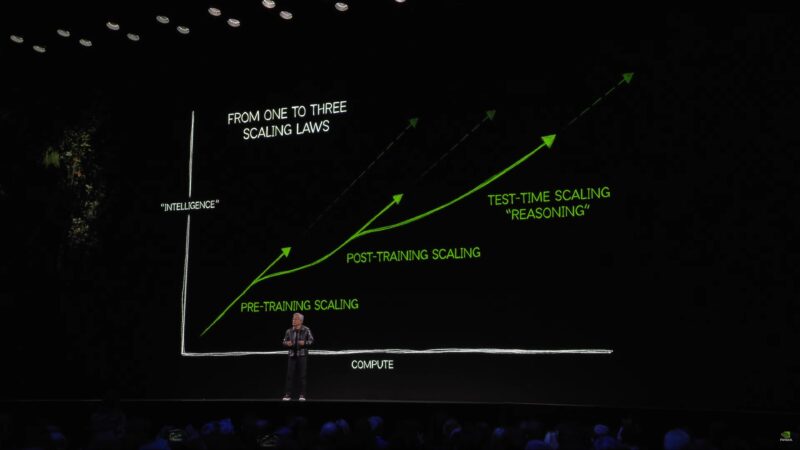
Post-training (AKA reinforcement learning). And then reasoning (test-time scaling) being the most recent addition to this pantheon – improvements while the AI is being used. Deciding how much computation actually needs to be used to produce the kind of answer that’s needed.
All of this requires significant compute resources. And limited compute resources. It’s driving enormous demand for NVIDIA’s Blackwell.
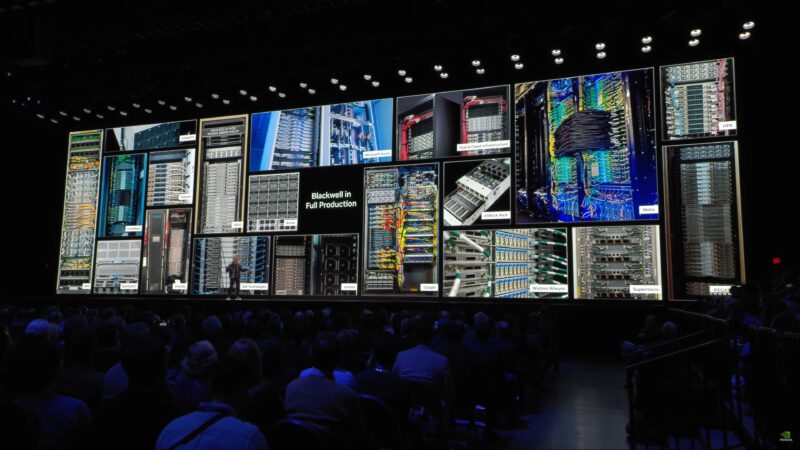
NVIDIA’s Blackwell is in full production. Between NVIDIA’s OEM partners and their own offerings, they can accommodate virtually every datacenter in the world.
“The reason that we’re driving it so hard is that we need a lot more computation”
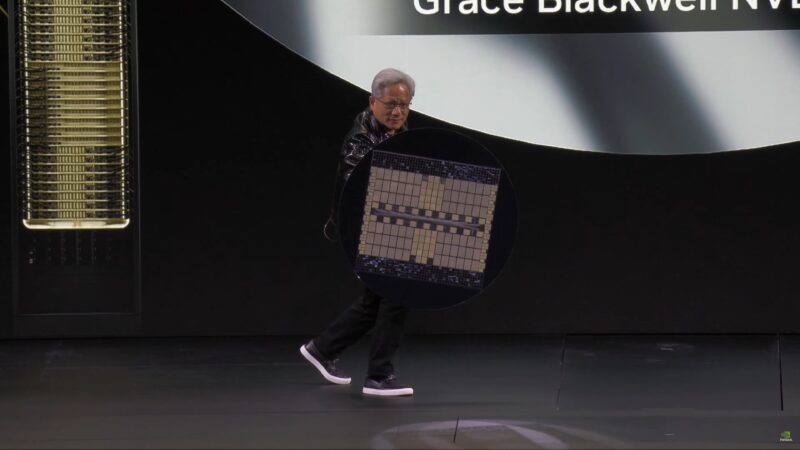
Jensen’s show-and-tell session has kicked off with what appears to be an enlarged version of a Blackwell GPU (ed: nope, it’s a Blackwell NVL72)
The manufacturing required for these AI servers is “insane.”
“In one generation we reduced the cost of training these models by a factor of 3.”
Datacenters are power limited at this point. So as Jensen believes, all the perf-per-watt improvements over the past generation directly translates to that much more revenue.
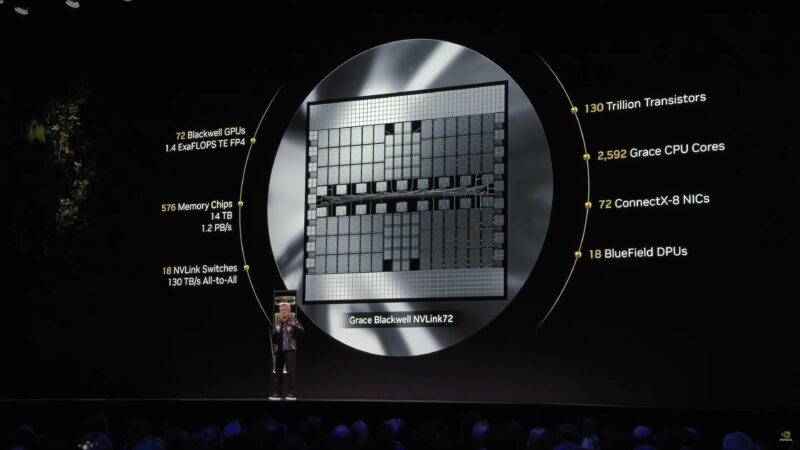
Suffice it to say, Jensen is very proud of what the company has accomplished with NVL72.
(He’s also looking a bit winded after moving around this rather large stage)
“We need the token generation rates to go way up” as well as for the cost of individual tokens to come down in cost in order to keep AI scaling overall.
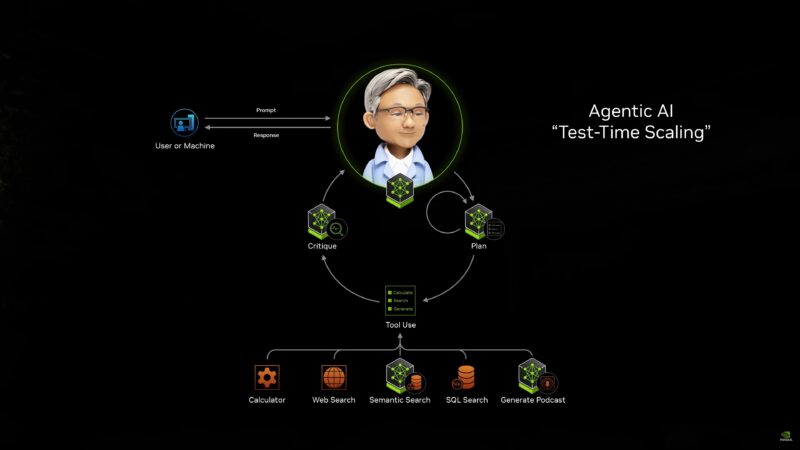
Jensen is discussing examples of AI agents and use cases.
With test-time scaling, the amount of computation used is going to go through the roof as answers get better.
NVIDIA has been promoting user-facing agents as a major use case for AI, and this is the latest iteration on that idea. And, of course, building all of that on top of NVIDIA’s hardware and their deep, deep software stack and model library.
In the future AI agents will be a digital workforce working alongside a company’s employees. (They’ll even need to be on-boarded, using specific libraries to train them on the company)
“Today we’re also announcing […] a whole family of models based off of Llama.” The NVIDIA Llama Nemotron Language Foundation Models.
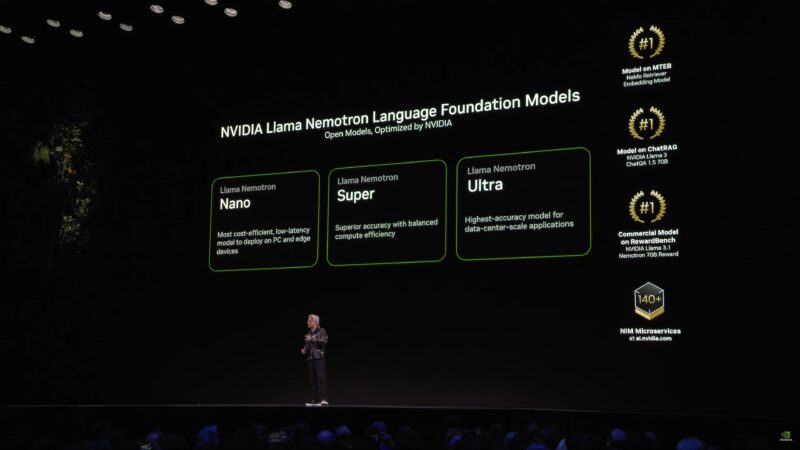
NVIDIA is fine-tuning the Llama models for enterprise use. 3 sizes: Nano (small), Super (mainstream), Ultra (large trainer).
Now on software coding: “This is going to be the next giant AI application”
AI agents is “likely to be a trillion dollar opportunity.”
Now rolling a video about AI agents and some of the things that users can do with them.
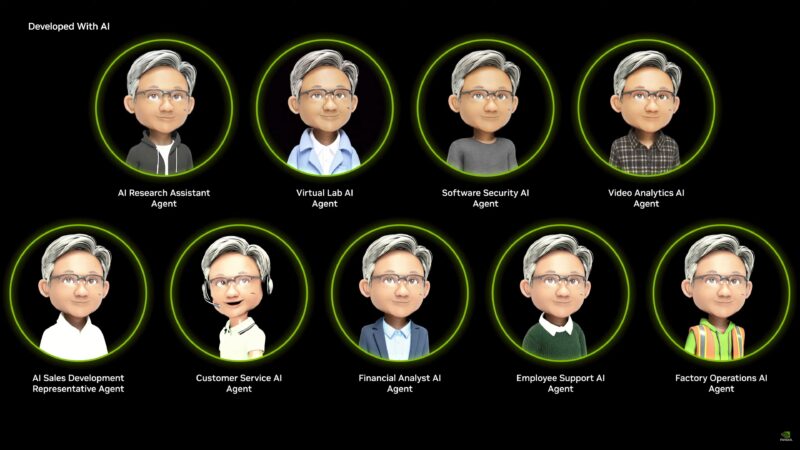
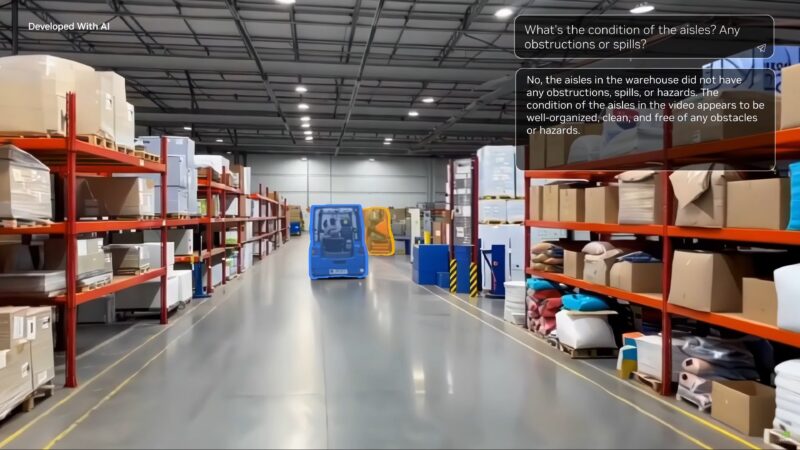
Jensen laments that the audience didn’t seem impressed. “That was not generated”
“The thing we want to do more than anything is put it [AI] on our PC itself”
The Windows OS model is not ideal for AI.
“If we could figure out a way to make Windows PC a world-class AI PC, that would be completely awesome”
The solution? The Windows Subsystem for Linux v2 (WSL2)
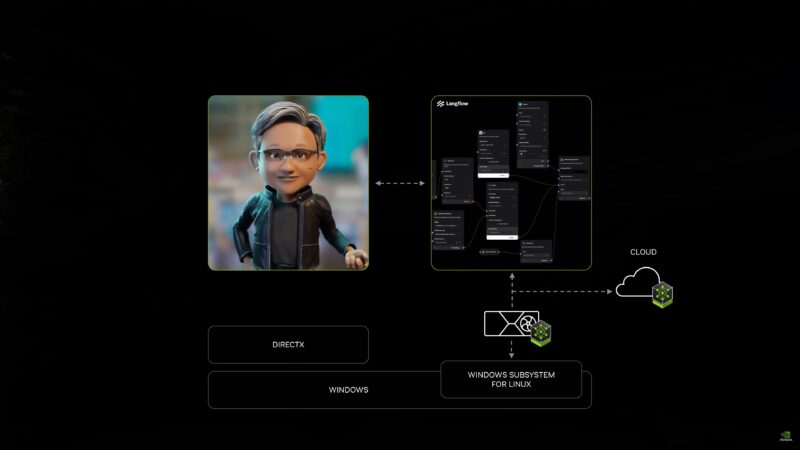
So leveraging Linux everywhere for the AI software ecosystem, even on Windows, it seems.
NVIDIA wants to turn Windows-via-WSL2 into a target, first-class platform.
And there is significant OEM buy-in as well. According to Jensen, they will be getting their machines ready for this software stack.
NVIDIA CES 2025 Physical AI
Shifting gears again, now we’re on to the subject of “physical AI”
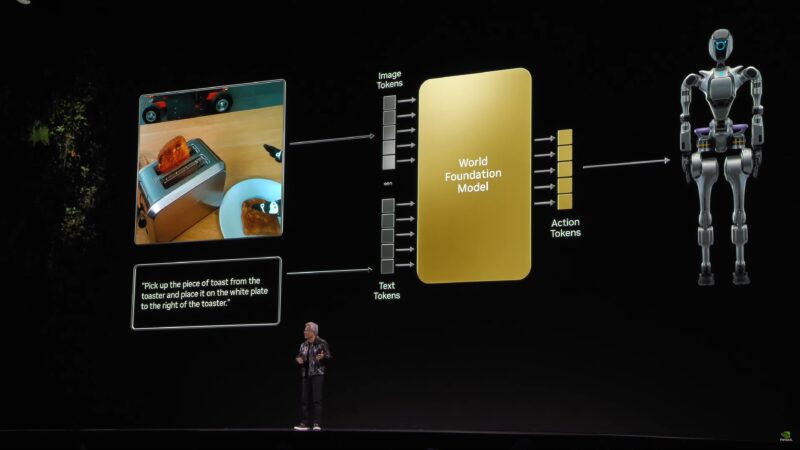
Part of the big computational workload of transformers is because the cost increases quadratically O(n^2) with the number of tokens.
“We need a world foundation model”
Announcing: NVIDIA Cosmos. A world foundation model designed to understand the physical world.
Now rolling a video.
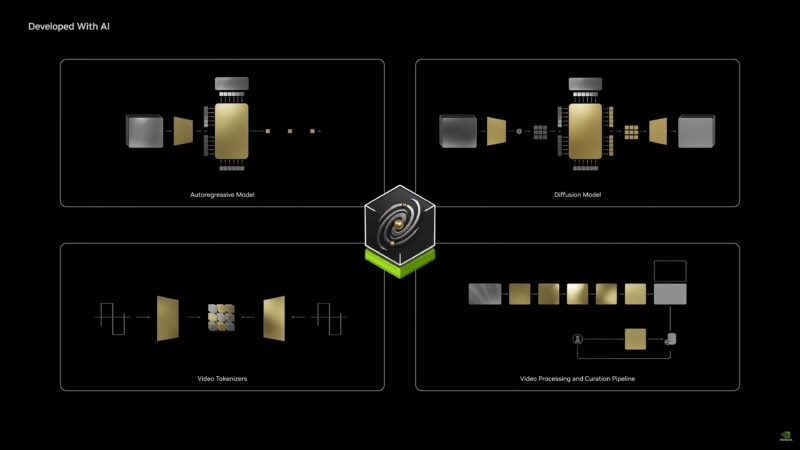
Generating a photorealistic world based on synthetic data. And then using the generated worlds in reinforcement training.
(This reads a lot like NVIDIA’s robotics pitches, but grounded in AI language)
Cosmos is trained on 20 million hours of video.
“Teaching the AI to understand the physical world.”
Cosmos is open licensed and is available on GitHub. It will come in three sizes, just like Nemotron: Nano, Super, and Ultra.
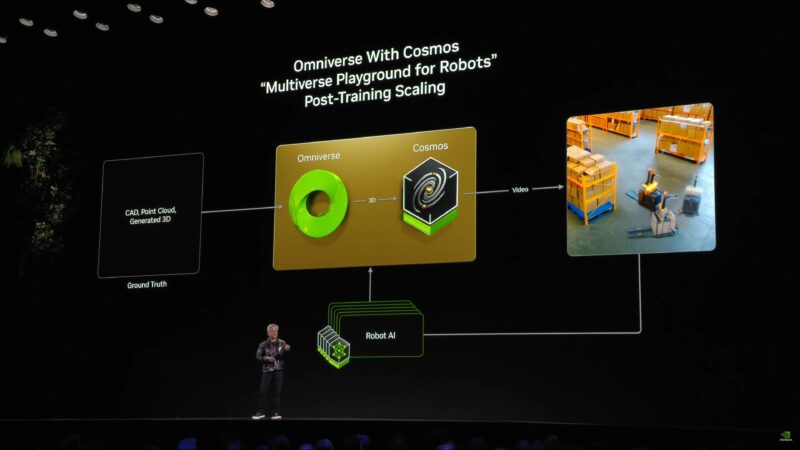
NVIDIA believes that robotics requires a 3 computer solution. A DGX system for base training, Omniverse with Cosmos for refining and reinforcement learning, and then AGX for inference in the real world.
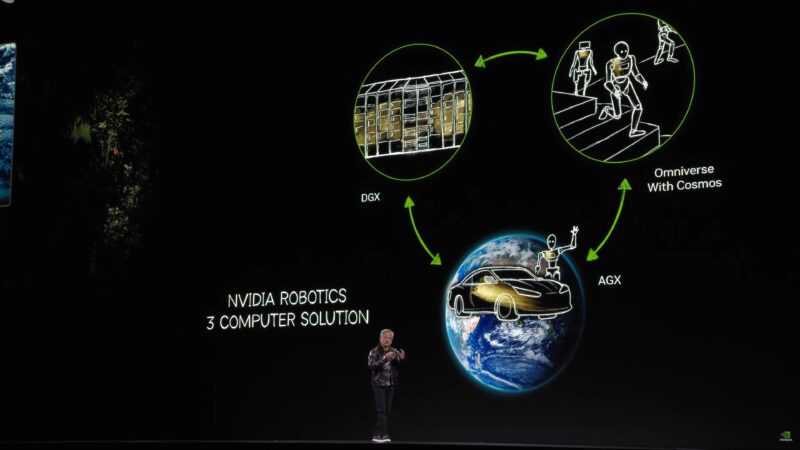
And NVIDIA has amassed a sizable number of ecosystem partners looking to make all of this happen.
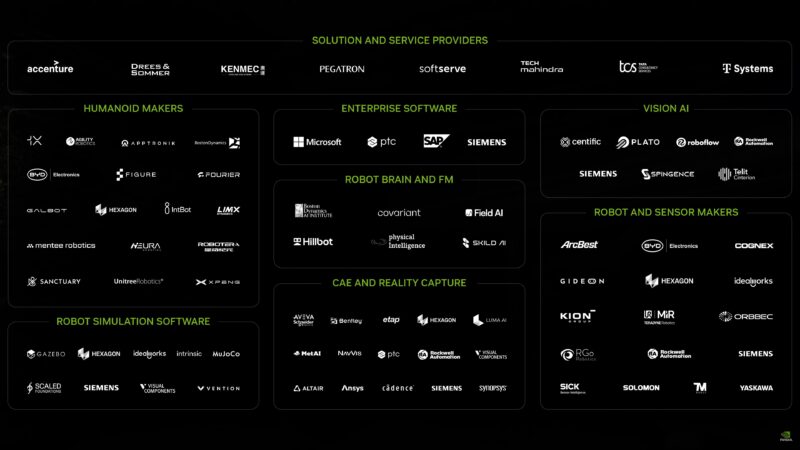
And now rolling another video, this time on a robotics project partnership. Everything is a simulation based on digital twinning.
NVIDIA CES 2025 Automotive
“The AV [autonomous vehicle] revolution has arrived”
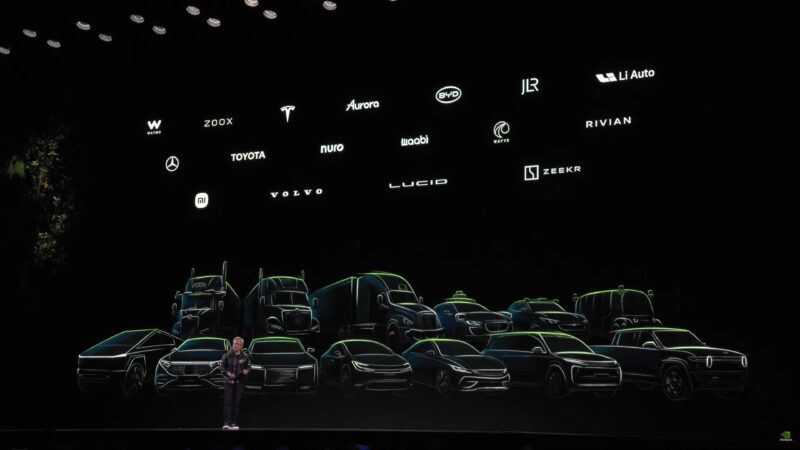
Announcing today that NVIDIA and Toyota are partnering for Toyota’s next generation of AVs.
“This will likely be the first multi-trillion dollar robotics industry”
The business has a run rate of $5B this year.
Announcing next generation automotive platform: Hyperion 9, based on NVIDIA Thor.
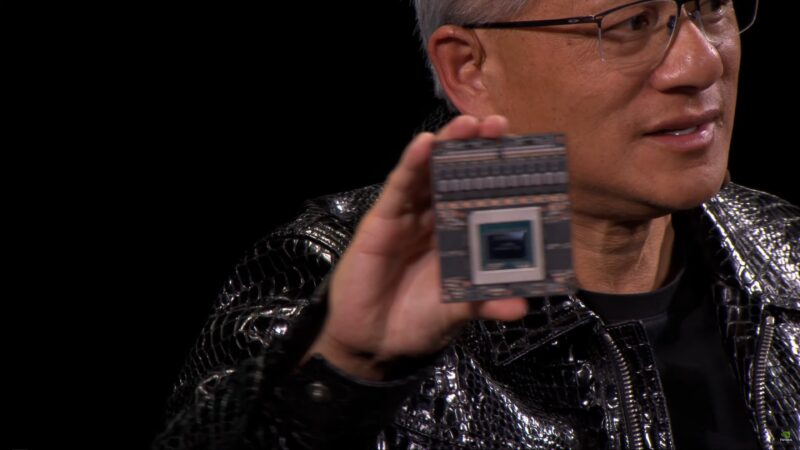
Thor is in full production. It has 20x the processing capabilities of Orin.
Thor is also available for traditional robotics.
Announcing: DRIVE OS is the first software defined AI computer that has been ASIL-D certified . “The only and the highest”
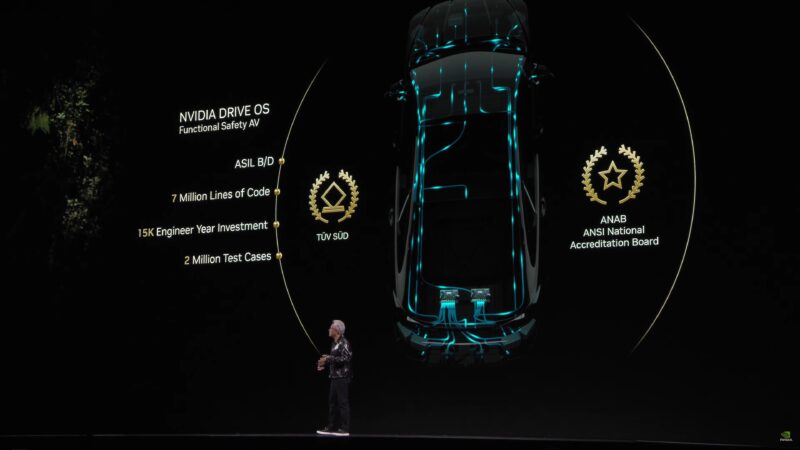
ASIL-D is the highest tier of Automotive Safety Integrity Level (ASIL) safety certification. So achieving D level certification is legitimately a big deal.
And now NVIDIA is rolling another video, this time talking about how various AI tools and techniques are used to train their AV models.
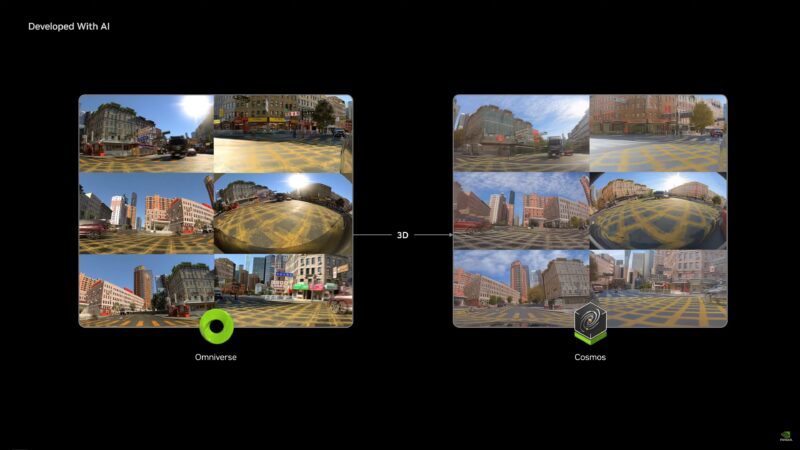
NVIDIA has been beating the drum of training for years, and continues to do so. In order to have workable and safe self-driving vehicles, those systems require massive amounts of training. Synthetic data generation is one of the ways that NVIDIA is increasing the amount of training.
And the pace of AV development is going to greatly increase over the next several years.
NVIDIA CES 2025 Robotics
Shifting gears once more, this time to robotics.
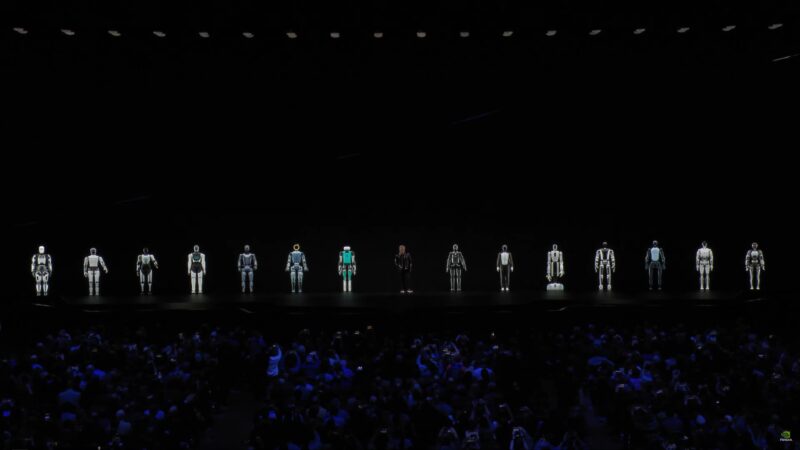
The critical capability? How to train these robots. With cars that’s easy – just drive them – but demoing how humans work to robots is far more laborious.
Rolling another video, this time about humanoid robots and suitable AI models.
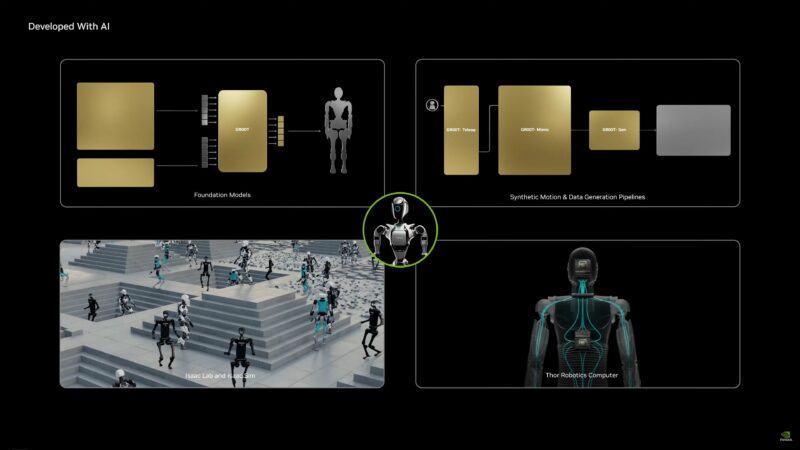
Using tele-operation and motion tracking with a human to create a baseline example, then generating many variations of it for training.
“We’re going to have mountains of data to train robots with”
NVIDIA CES 2025 DGX Systems
Pivoting yet again, Jensen is now on to NVIDIA’s in-house developed DGX systems. Recapping the history of DGX, and noting that the company first released DGX in 2016.
“I just wish DGX-1 [NVIDIA’s first system] was smaller”
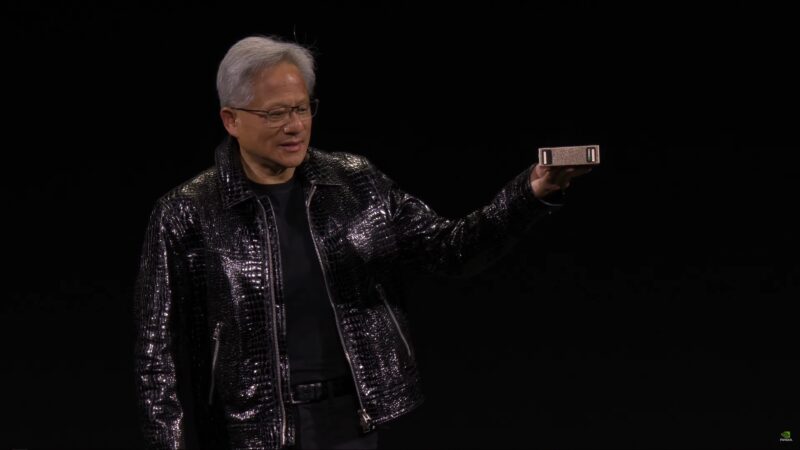
Project DIGITS: a tiny NVIDIA AI “supercomputer”.
Based on a new chip called GB110. The smallest Blackwell GPU that NVIDIA makes.
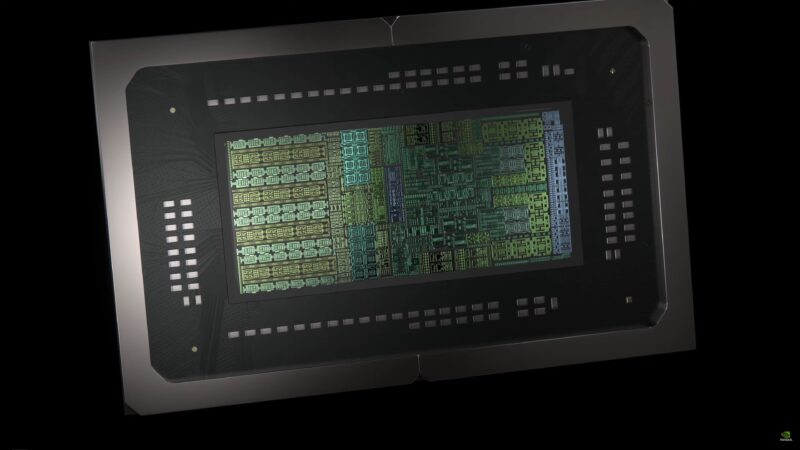
GB110 is in production. It goes in to the GB10 Superchip, which is a combination Grace + Blackwell part. Built in collaboration with MediaTek? Interesting…
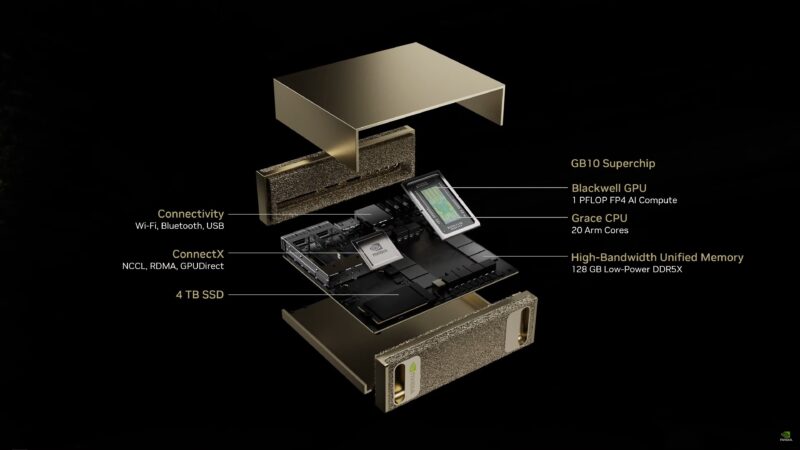
Available in the May timeframe.
It can also be used as a Linux workstaiton. So this is a lot more than a bland industrial PC.
20 Arm CPU cores. A small Blackwell GPU. 128GB of LPDDR5X. GB10 looks a lot like a contemporary SoC, but without the on-die I/O. And I can’t imagine NVIDIA is going to stop by just putting it in a mini-PC for developers.
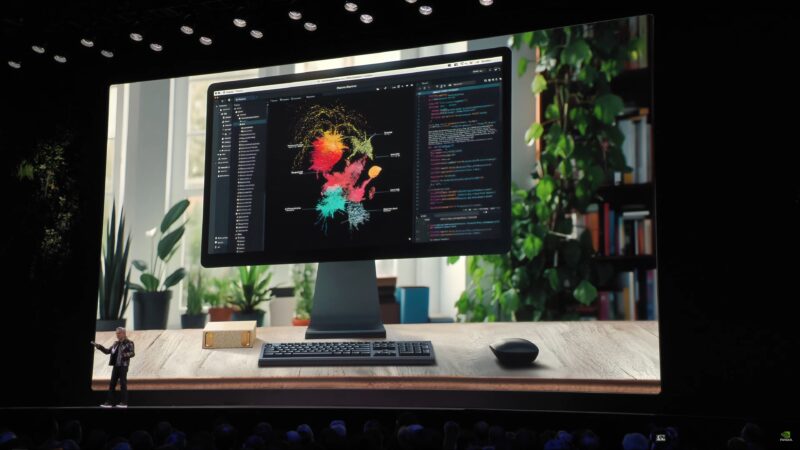
Recap time. NVIDIA is in production with three new Blackwells. And 2025 will be an amazing year.
Heading out, here’s one last video of everything NVIDIA has been up to.
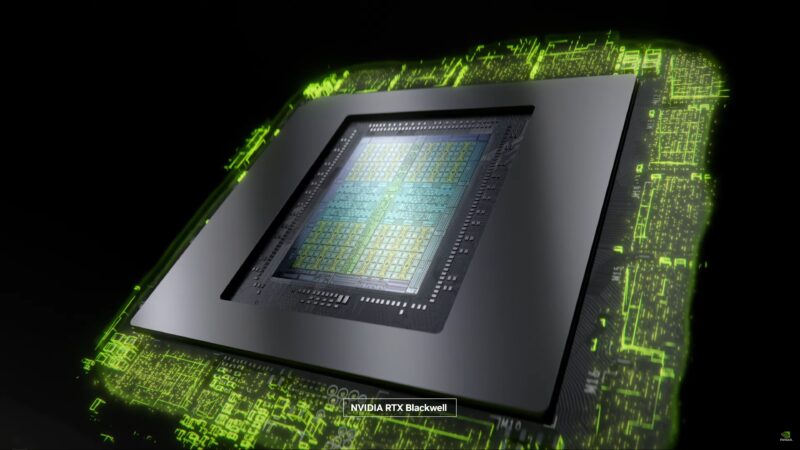
“Have a great CES everybody!”
And that’s a wrap.
Final Words
The final keynote of the night, NVIDIA’s CES keynote has managed to deliver a little something for everyone – and for gamers. a lot more.
The highlight on the consumer side of matters is clear the GeForce RTX 5000 series, which is the consumer adaptation of NVIDIA’s Blackwell GPU architecture. While the details in the keynote are a bit slim (I expect a more dedicated disclosure in the near future), the top-end Blackwell GPU, used in the GeForce RTX 5090, is going to be packing 92 billion transistors, and is backed by GDDR7 memory. NVIDIA is touting between 1.5x and 3x the performance of their top Ada chip, depending on if you’re looking at shading performance (1.5x), RT performance (2x), or AI performance (3x). A lot of the lifting on the latter is undoubtedly being done by support for low-precision FP4/INT4 datatypes.
It also sounds like NVIDIA has several new features in store for the GeForce family, though they didn’t go into detail about them during the keynote. This includes a new version of their Reflex latency reduction tools (Reflex 2), DLSS 4 with the ability to generate up to 3 frames between real keyframes, and neural texturing. And all of this is being underpinned by an improved ability to mix AI and shader operations within NVIDIA’s programmable CUDA shader cores.
The resulting GeForce RTX 5000 family is launching this month and extending through February, starting with the $1999 GeForce RTX 5090 (up from $1599 for 4090), the $999 RTX 5080 (down from $1199), the $749 RTX 5070 Ti (down from $799), and the $549 RTX 5070 ($599). That prices for most of the SKUs has dropped from one generation to the next is a very surprising move given the ever-increasing costs of wafers – not to mention NVIDIA’s dominant market position – so it will be interesting to see just how the underlying hardware compares, and how much more in the way of functional blocks/transistors are coming with the GPUs in these new cards at each tier.
And riding the fence of consumer hardware, NVIDIA’s GB10 Superchip will bear paying attention to. The (seemingly?) multi-die chiplet part combines a CPU die with 20 Arm cores with a Blackwell GPU die. It’s not quite a SoC (the I/O connectivity appears to be in a separate, off-package chip), but it’s the closest thing NVIDIA has offered to a consumer SoC in several years. That will first be going into NVIDIA’s Project DIGITS mini-PC, which is due out in May for $3000.
Finally, NVIDIA announced a number of AI-related developments, mostly on the software side of matters. Nemotron for optimizing Llama models, Cosmos for generating photorealistic images from synthetically generated worlds, and a big push for the development of AI agents, with NVIDIA lining up an increasingly large toolset to help build them. Even the automotive side of NVIDIA got a bit of time tonight, with the announcement that the Orin SoC is in full production, and that NVIDIA has inked a partnership with Toyota for their next generation of self-driving vehicles.

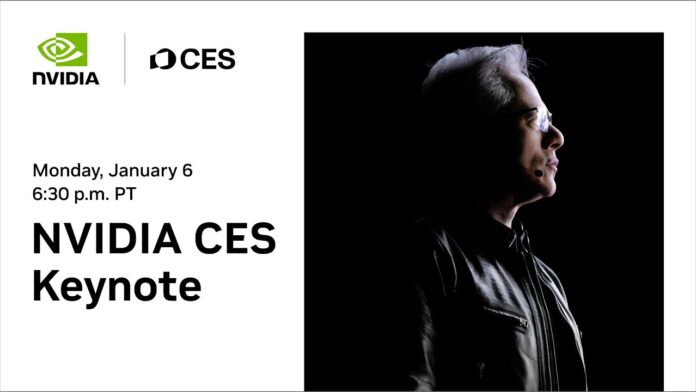


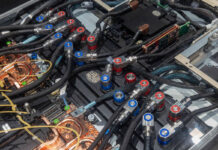
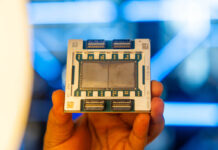

Super glad to see Ryan wound up here! I loved these types of live coverage articles. So this is a great pairing between STH and Ryan. Super excited about the new GPUs being introduced soon!
Another nice write-up Ryan. It’s been nice to “hear” from you again!